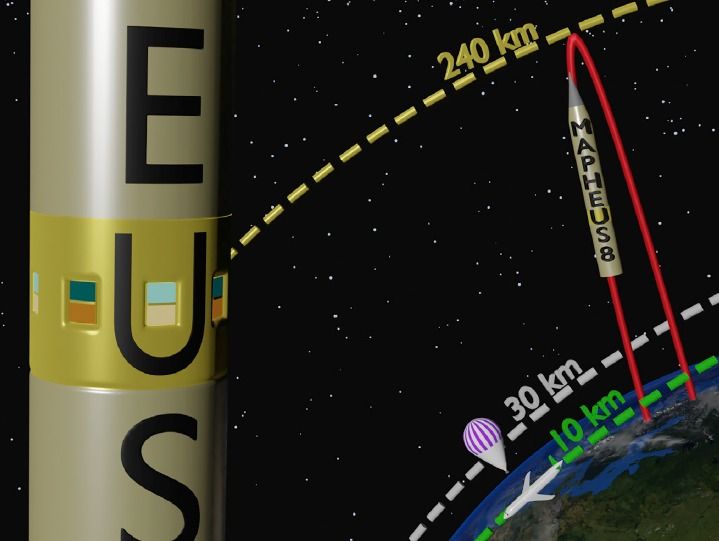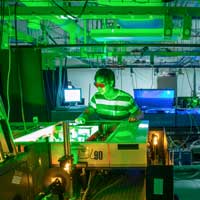Researchers from Germany sent solar cells into low-Earth Orbit to see how well they might perform in longer, deep space missions.



A machine-learning algorithm that can predict the compositions of trend-defying new materials has been developed by RIKEN chemists1. It will be useful for finding materials for applications where there is a trade-off between two or more desirable properties.
Artificial intelligence has great potential to help scientists find new materials with desirable properties. A machine-learning algorithm that has been trained with the compositions and properties of known materials can predict the properties of unknown materials, saving much time in the lab.
But discovering new materials for applications can be tricky because there is often a trade-off between two or more material properties. One example is organic materials for organic solar cells, where it is desired to maximize both the voltage and current, notes Kei Terayama, who was at the RIKEN Center for Advanced Intelligence Project and is now at Yokohama City University. “There’s a trade-off between voltage and current: a material that exhibits a high voltage will have a low current, whereas one with a high current will have a low voltage.”

By formulating positively charged fluorescent dyes into a new class of materials called small-molecule ionic isolation lattices (SMILES), a compound’s brilliant glow can be seamlessly transferred to a solid, crystalline state, researchers report August 6 in the journal Chem. The advance overcomes a long-standing barrier to developing fluorescent solids, resulting in the brightest known materials in existence.
“These materials have potential applications in any technology that needs bright fluorescence or calls for designing optical properties, including solar energy harvesting, bioimaging, and lasers,” says Amar Flood, a chemist at Indiana University and co-senior author on the study along with Bo Laursen of the University of Copenhagen.
“Beyond these, there are interesting applications that include upconverting light to capture more of the solar spectrum in solar cells, light-switchable materials used for information storage and photochromic glass, and circularly polarized luminescence that may be used in 3D display technology,” Flood says.
Solar power, hydrogen fuel from seawater, automatic wingsails, a 6 year journey.
The Energy Observer set sail on a six-year world tour in 2017, testing new technologies, from onboard hydrogen electrolysis to fully-automated sails. It’s hoped the rugged ocean environment will prove the techs’ durability and usefulness at home.
CNET playlists: https://www.youtube.com/user/CNETTV/playlists
Download the new CNET app: https://cnet.app.link/GWuXq8ExzG
Like us on Facebook: https://www.facebook.com/cnet
Follow us on Twitter: https://www.twitter.com/cnet
Follow us on Instagram: http://bit.ly/2icCYYm
#EnergyObserver #Hydrogen #Toyota
Just a few years ago, low cost natural gas was the main force pushing coal out of the power generation market, and now low cost solar power is sneaking up on low cost natural gas. So far the competition is a trickle, not a flood. However, natural gas stakeholders don’t have much breathing room left, as indicated by the latest perovskite solar cell research.

We are closer to being able to build a Dyson Sphere than we think. By enveloping the sun in a massive sphere of artificial habitats and solar panels, a Dyson Sphere would provide us with more energy than we would ever know what to do with while dramatically increasing our living space. Implausible you say? Something for our distant descendants to consider? Think again. We could conceivably get going on the project in about 25 to 50 years, with completion of the first phase requiring only a few decades.

(Nanowerk News) Scientists in Australia and the United States have been able to ‘upconvert’ low energy light into high energy light, which can be captured by solar cells, in a new way, with oxygen the surprise secret ingredient. The results are published in Nature Photonics (“Photochemical upconversion of near-infrared light from below the silicon bandgap”).
Scientists in Australia and the United States have been able to ‘upconvert’ low energy light into high energy light, which can be captured by solar cells, in a new way, with oxygen the surprise secret ingredient.
The results are published in Nature Photonics (“Photochemical upconversion of near-infrared light from below the silicon bandgap”).
While the approach’s efficiencies are relatively low and more work is needed to achieve commercialisation, the research is an exciting development, according to senior author Professor Tim Schmidt from the ARC Centre of Excellence in Exciton Science and UNSW Sydney.
“The energy from the sun is not just visible light,” Prof. Schmidt explains.

Engineers have developed a new type of hybrid solar energy converter, which uses energy from the Sun to create both electricity and steam. The device reportedly has high efficiency and runs at low cost, allowing industry to make use of a wider spectrum of solar energy.
The most common way of collecting energy from the Sun is through photovoltaics. These solar cells produce electricity from sunlight, and they’re so simple that they’re built into everything from garden lights to the grid itself.
But it’s not the only way. Solar concentrators collect heat instead of light, focusing the Sun’s rays to heat up a contained fluid. This can then be used to generate electricity – say as steam turning a turbine – or more directly, to heat homes or for other industrial processes.


Chemists at the University of Wisconsin-Madison and their collaborators have created a highly efficient and long-lasting solar flow battery, a way to generate, store and redeliver renewable electricity from the sun in one device.
The new device is made of silicon solar cells combined with advanced solar materials integrated with optimally designed chemical components. The solar flow battery, made by the Song Jin lab in the UW-Madison chemistry department, achieved a new record efficiency of 20 percent. That bests most commercially available silicon solar cells used today and is 40 percent more efficient than the previous record holder for solar flow batteries, also developed by the Jin lab.